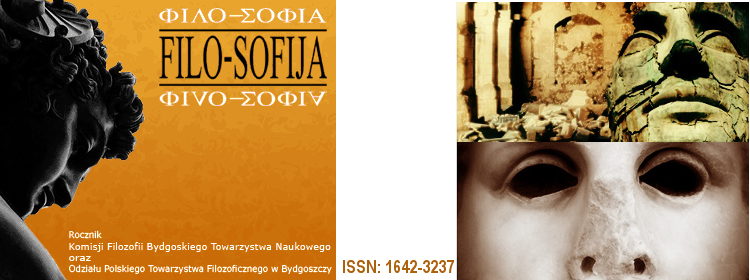WŇāadysŇāawa Tatarkiewicza alternatywna definicja sztuki a analityczna filozofia sztuki
Abstract
Author: Bogusz-BoŇātuńá Ewa
Title: WŇĀADYSŇĀAW TATARKIEWICZ‚ÄôS DISJUNCTIVE DEFINITION OF ART. IN ANALYTIC PHILOSOPHY OF ART (WŇāadysŇāawa Tatarkiewicza alternatywna definicja sztuki a analityczna filozofia sztuki)
Source: Filo-Sofija
year: 2011, vol:.13/14, number: 2011/2-3, pages: 591-600
Keywords: WŇĀADYSŇĀAW TATARKIEWICZ, ALTERNATIVE DEFINITION OF ART, DISJUNCTIVE DEFINITION OF ART, BERYS GAUT
Discipline: PHILOSOPHY
Language: POLISH
Document type: ARTICLE
Publication order reference (Primary author’s office address):
E-mail:
www:
Abstract As a historian of ideas, WŇāadysŇāaw Tatarkiewicz sought to introduce order to the meanders of philosophical debates of the past, but as a philosopher, he tried to determine what a given thing is. In this essay I will attempt to show that the voice of Tatarkiewicz was significant for the philosophical debate about ‚Äėwhat art is?‚Äô. In the fifties of the twentieth century, Morris Weitz concluded that defining art through describing the necessary and sufficient conditions for something to be a work of art, is unfounded. His thesis not only began the anti-essentialist trend in analytic aesthetics, but also prompted attempts to define art by drawing attention to its relational properties. In the disjunctive definition of art, which he formulated in the late 1960s, WŇāadysŇāaw Tatarkiewicz opened a new option, where to get something regarded as a work; it is enough to set certain minimal sufficient conditions. What‚Äôs more, this way of defining art seems to be one of the more promising projects. The latest version of the disjunctive definition of art, the cluster definition of art by Berys Gaut, is also part of a trend set by the Tatarkiewicz‚Äôs definition.
Title: WŇĀADYSŇĀAW TATARKIEWICZ‚ÄôS DISJUNCTIVE DEFINITION OF ART. IN ANALYTIC PHILOSOPHY OF ART (WŇāadysŇāawa Tatarkiewicza alternatywna definicja sztuki a analityczna filozofia sztuki)
Source: Filo-Sofija
year: 2011, vol:.13/14, number: 2011/2-3, pages: 591-600
Keywords: WŇĀADYSŇĀAW TATARKIEWICZ, ALTERNATIVE DEFINITION OF ART, DISJUNCTIVE DEFINITION OF ART, BERYS GAUT
Discipline: PHILOSOPHY
Language: POLISH
Document type: ARTICLE
Publication order reference (Primary author’s office address):
E-mail:
www:
Abstract As a historian of ideas, WŇāadysŇāaw Tatarkiewicz sought to introduce order to the meanders of philosophical debates of the past, but as a philosopher, he tried to determine what a given thing is. In this essay I will attempt to show that the voice of Tatarkiewicz was significant for the philosophical debate about ‚Äėwhat art is?‚Äô. In the fifties of the twentieth century, Morris Weitz concluded that defining art through describing the necessary and sufficient conditions for something to be a work of art, is unfounded. His thesis not only began the anti-essentialist trend in analytic aesthetics, but also prompted attempts to define art by drawing attention to its relational properties. In the disjunctive definition of art, which he formulated in the late 1960s, WŇāadysŇāaw Tatarkiewicz opened a new option, where to get something regarded as a work; it is enough to set certain minimal sufficient conditions. What‚Äôs more, this way of defining art seems to be one of the more promising projects. The latest version of the disjunctive definition of art, the cluster definition of art by Berys Gaut, is also part of a trend set by the Tatarkiewicz‚Äôs definition.
PeŇāny tekst:
PDFAdministracja Cytowania | Strony czasopism
